|
Deep Purple - "Concerto for Group and Orchestra" (Harvest 1969)
 Deep Purple was one of the most influential and important hard rock bands in the '70s. Their earliest phase in the late 60's is of interest to die-hard fans only. Their three first albums were messy efforts with lots of cover versions and the self-penned material lacked direction and focus. But that was soon to end when singer Ian Gillan and bassist Roger Glover joined the band. The rest of the classic MKII line-up consisted of keyboardist Jon Lord, guitarist Ritchie Blackmore and drummer Ian Paice. However, the new version of Deep Purple didn't start very promising with "Concerto for Group and Orchestra". The whole thing was recorded live at the Royal Albert Hall with the Royal Philharmonic Orchestra. Yes, "Concerto for Group and Orchestra" was one of the many attempts from the late 60's/early '70s of fusing a symphonic orchestra with the rock band. And as in most other cases, it didn't work that entire well. I think the first movement explains why: it starts with the orchestra playing a complex part with several different themes for 8-minutes. Then suddenly out from nowhere kicks the band in and starts some aggressive jamming while the orchestra keeps completely quiet. This goes on for about 4-5 minutes before the band stops playing and the orchestra starts again. Got the clue? There's almost NO fusion between the orchestra and the band, so the album falls pretty much flat on its face as it fails to fulfil its own ambitions. The 2nd movement is much more low-key and kind of gloomy and sinister. A wonderful vocal-part starts after the first few minutes and it have got a really good melody. The movement then continues on side 2 and consists mostly of dialogues between Lord's organ and the orchestra. The 3rd movement is more up-tempo and it sounds like they have got a little bit closer to melting the orchestra with the band here than on the two first movements. Overall, there are several tendencies to good things on the album and the playing of both the band and orchestra sounds very good and inspired. But as a whole, the album is still a failure and remains not much else than an early progressive experiment that went wrong. Deep Purple was one of the most influential and important hard rock bands in the '70s. Their earliest phase in the late 60's is of interest to die-hard fans only. Their three first albums were messy efforts with lots of cover versions and the self-penned material lacked direction and focus. But that was soon to end when singer Ian Gillan and bassist Roger Glover joined the band. The rest of the classic MKII line-up consisted of keyboardist Jon Lord, guitarist Ritchie Blackmore and drummer Ian Paice. However, the new version of Deep Purple didn't start very promising with "Concerto for Group and Orchestra". The whole thing was recorded live at the Royal Albert Hall with the Royal Philharmonic Orchestra. Yes, "Concerto for Group and Orchestra" was one of the many attempts from the late 60's/early '70s of fusing a symphonic orchestra with the rock band. And as in most other cases, it didn't work that entire well. I think the first movement explains why: it starts with the orchestra playing a complex part with several different themes for 8-minutes. Then suddenly out from nowhere kicks the band in and starts some aggressive jamming while the orchestra keeps completely quiet. This goes on for about 4-5 minutes before the band stops playing and the orchestra starts again. Got the clue? There's almost NO fusion between the orchestra and the band, so the album falls pretty much flat on its face as it fails to fulfil its own ambitions. The 2nd movement is much more low-key and kind of gloomy and sinister. A wonderful vocal-part starts after the first few minutes and it have got a really good melody. The movement then continues on side 2 and consists mostly of dialogues between Lord's organ and the orchestra. The 3rd movement is more up-tempo and it sounds like they have got a little bit closer to melting the orchestra with the band here than on the two first movements. Overall, there are several tendencies to good things on the album and the playing of both the band and orchestra sounds very good and inspired. But as a whole, the album is still a failure and remains not much else than an early progressive experiment that went wrong.
Deep Purple - "In Rock" (Harvest 1970)
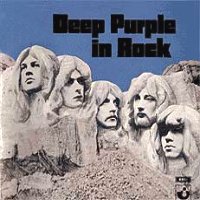 After the artistic fiasco of "Concerto for Group and Orchestra", Purple finally found their ultimate style on the groundbreaking and ear shattering "In Rock". The album stands as one of the definitive hard rock classics of all time, and immediately made them one of the most important and influential bands of the genre. Ian Gillan revealed himself as perhaps the first true heavy metal singer ever, and demonstrated his range and power beyond any doubt on the masterpiece "Child in Time". The song was a kind of a progressive ballad, with some Emerson-like organ and a vocal melody that few other than Gillan could sing. But the rest of the album was a merciless collection of heavy riffs and extended, aggressive solo-passages. The opener "Speed King" was heavier and more brutal than anything people had heard before, but Purple again showed their sophistication by slowing the song down in the middle and make space for some jazzy solos from Blackmore and Lord. "Into the Fire" is a simple but effective heavy stomper; the same can be said about "Bloodsucker". "Living Wreck" relies a bit more on melody, while "Flight of the Rat" and "Hard Lovin' Man" were lengthier tracks with lots duels between Lord and Blackmore. Classic hard rock doesn't get better than "In Rock". Essential and obligatory album for anyone with the slightest interest in the genre. After the artistic fiasco of "Concerto for Group and Orchestra", Purple finally found their ultimate style on the groundbreaking and ear shattering "In Rock". The album stands as one of the definitive hard rock classics of all time, and immediately made them one of the most important and influential bands of the genre. Ian Gillan revealed himself as perhaps the first true heavy metal singer ever, and demonstrated his range and power beyond any doubt on the masterpiece "Child in Time". The song was a kind of a progressive ballad, with some Emerson-like organ and a vocal melody that few other than Gillan could sing. But the rest of the album was a merciless collection of heavy riffs and extended, aggressive solo-passages. The opener "Speed King" was heavier and more brutal than anything people had heard before, but Purple again showed their sophistication by slowing the song down in the middle and make space for some jazzy solos from Blackmore and Lord. "Into the Fire" is a simple but effective heavy stomper; the same can be said about "Bloodsucker". "Living Wreck" relies a bit more on melody, while "Flight of the Rat" and "Hard Lovin' Man" were lengthier tracks with lots duels between Lord and Blackmore. Classic hard rock doesn't get better than "In Rock". Essential and obligatory album for anyone with the slightest interest in the genre.
Deep Purple - "Fireball" (Harvest 1971)
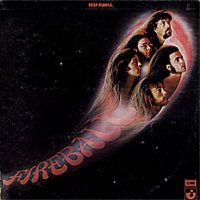 "Fireball" was yet another strong album but relied more on mid-tempo grooves than "In Rock" and didn't have the same sonic assault. The only exception was probably the speedy and energetic title-track. The most surprising song here was undoubtedly the pleasant country of "Anyone's Daughter". A very good tune, but maybe a bit out of place on the album. "No No No" and "Demon's Eye" were good mid-tempo tracks, and the groove was even better on the slightly faster "No One Came". There were also two more progressive tracks on the album. The mystical "The Mule" was based around a powerful drum-riff, and had an almost spacey atmosphere. "Fools" was a more sinister track, featuring some of the hardest riffs on the album, but also quiet and atmospheric passages. It's a well-known fact that Blackmore hates this album, but you shouldn't care much about that (or anything else he has said). "Fireball" is classic Purple, no matter what the grumpy old guitar-wanker thinks about it. "Fireball" was yet another strong album but relied more on mid-tempo grooves than "In Rock" and didn't have the same sonic assault. The only exception was probably the speedy and energetic title-track. The most surprising song here was undoubtedly the pleasant country of "Anyone's Daughter". A very good tune, but maybe a bit out of place on the album. "No No No" and "Demon's Eye" were good mid-tempo tracks, and the groove was even better on the slightly faster "No One Came". There were also two more progressive tracks on the album. The mystical "The Mule" was based around a powerful drum-riff, and had an almost spacey atmosphere. "Fools" was a more sinister track, featuring some of the hardest riffs on the album, but also quiet and atmospheric passages. It's a well-known fact that Blackmore hates this album, but you shouldn't care much about that (or anything else he has said). "Fireball" is classic Purple, no matter what the grumpy old guitar-wanker thinks about it.
Deep Purple - "Machine Head" (Purple 1972)
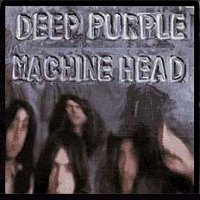 This is often hailed as Purple's definitive album, and it includes their signature tune "Smoke on the Water". If you don't know this tune and its legendary riff, then you probably haven't listened to rock music at all. The song became extremely popular, and Purple have NEVER played a concert without it since the release of "Machine Head". The lyrics were funnily enough about the recording of the album, and all the unexpected things and problems that occurred during the process. Musically, the album is a bit more basic and simpler than both "In Rock" and "Fireball". Most hints of progressive elements were taken away, and the music was stripped down to just the heavy riffs. But there was still space for instrumental excursions, especially on the opener "Highway Star"(with lots of great, classical-influenced solos) and the slightly more bluesy "Lazy". "Never Before" "Maybe I'm a Leo" and the better known "Space Truckin'" featured some of the catchiest riffs on the record. "Pictures of Home" had a fast pace and a melodic main-theme, and stands as one of the most overlooked tracks in Purple's repertoire. Personally I prefer "In Rock" over "Machine Head", but there's no point in denying that the album features some of Purple's best and most enduring material, and there's not a bad or weak spot on it at all. This is often hailed as Purple's definitive album, and it includes their signature tune "Smoke on the Water". If you don't know this tune and its legendary riff, then you probably haven't listened to rock music at all. The song became extremely popular, and Purple have NEVER played a concert without it since the release of "Machine Head". The lyrics were funnily enough about the recording of the album, and all the unexpected things and problems that occurred during the process. Musically, the album is a bit more basic and simpler than both "In Rock" and "Fireball". Most hints of progressive elements were taken away, and the music was stripped down to just the heavy riffs. But there was still space for instrumental excursions, especially on the opener "Highway Star"(with lots of great, classical-influenced solos) and the slightly more bluesy "Lazy". "Never Before" "Maybe I'm a Leo" and the better known "Space Truckin'" featured some of the catchiest riffs on the record. "Pictures of Home" had a fast pace and a melodic main-theme, and stands as one of the most overlooked tracks in Purple's repertoire. Personally I prefer "In Rock" over "Machine Head", but there's no point in denying that the album features some of Purple's best and most enduring material, and there's not a bad or weak spot on it at all.
Deep Purple - "Made in Japan" (Purple 1972)
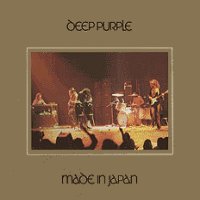 The best line-up of Purple delivered their last classic release with the double live-album "Made in Japan". Many people rates it as the best live-album of all times, and it's no doubt that Purple in their prime was one of the best, most inspired and energetic bands you could get on stage. The album was, as you may could guess, recorded in Japan on the tour for "Machine Head" in 1972. It kicks of with a version of "Highway Star" that makes the studio-version sound tame in comparison. The quiet parts of "Child in Time" are not quite on par with the original version, but the screaming of Gillan is really impressive, even live. "Smoke on the Water" is pure killer here, with a more powerful groove than on the version on "Machine Head". The version of "The Mule" is the weak point of the album, as most of it is taken up of a drum-solo, and the track itself is played a bit uninspired and wimpy. "Strange Kind of Woman" features of course the legendary dialogue between Gillan's voice and Blackmore's guitar, and they never did it better than on this recording. "Lazy" has got a slightly longer intro, with lots of feedback and distorted organ from Lord. But the most impressive performance comes in form of a 20-minute version of "Space Truckin'". The track had been extended by a very intense and energetic instrumental section where the whole band stretches out, and it don't become boring for a second (and that's rare for a 4-minute song extended this much on stage). The best line-up of Purple delivered their last classic release with the double live-album "Made in Japan". Many people rates it as the best live-album of all times, and it's no doubt that Purple in their prime was one of the best, most inspired and energetic bands you could get on stage. The album was, as you may could guess, recorded in Japan on the tour for "Machine Head" in 1972. It kicks of with a version of "Highway Star" that makes the studio-version sound tame in comparison. The quiet parts of "Child in Time" are not quite on par with the original version, but the screaming of Gillan is really impressive, even live. "Smoke on the Water" is pure killer here, with a more powerful groove than on the version on "Machine Head". The version of "The Mule" is the weak point of the album, as most of it is taken up of a drum-solo, and the track itself is played a bit uninspired and wimpy. "Strange Kind of Woman" features of course the legendary dialogue between Gillan's voice and Blackmore's guitar, and they never did it better than on this recording. "Lazy" has got a slightly longer intro, with lots of feedback and distorted organ from Lord. But the most impressive performance comes in form of a 20-minute version of "Space Truckin'". The track had been extended by a very intense and energetic instrumental section where the whole band stretches out, and it don't become boring for a second (and that's rare for a 4-minute song extended this much on stage).
Deep Purple - "Who Do We Think We Are?" (Purple 1973)
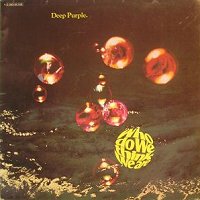 The last album of the classic line-up was not in the same class as "In Rock", "Fireball" and "Machine Head". It opens with the classic "Woman from Tokyo" and features also the superb "Smooth Dancer" but those were also the two only really consistent tracks on the album. "Mary Long" is an uninspired attempt at maintaining the sound of "Machine Head", but suffers from a generic melody. "Super Trooper" experiments with some psychedelic twists on the vocals to cover over the mediocrity of the track itself. "Rat Bat Blue" has a cool riff and some classical-influenced instrumental passages, but the verses sounds chaotic and clumsy. "Place in Line" have to be one of the most boring tracks the classic line-up recorded in the '70s. It's basically just some bluesy mid-tempo drivel with no sign of a good riff or melody. The melodic pomp rock of the closing-number "Our Lady" is decent, but not classic Purple. Overall, the weakest album of the classic line-up in the '70s, but it's a masterpiece compared to anything Purple have done after the re-union in 1984. The last album of the classic line-up was not in the same class as "In Rock", "Fireball" and "Machine Head". It opens with the classic "Woman from Tokyo" and features also the superb "Smooth Dancer" but those were also the two only really consistent tracks on the album. "Mary Long" is an uninspired attempt at maintaining the sound of "Machine Head", but suffers from a generic melody. "Super Trooper" experiments with some psychedelic twists on the vocals to cover over the mediocrity of the track itself. "Rat Bat Blue" has a cool riff and some classical-influenced instrumental passages, but the verses sounds chaotic and clumsy. "Place in Line" have to be one of the most boring tracks the classic line-up recorded in the '70s. It's basically just some bluesy mid-tempo drivel with no sign of a good riff or melody. The melodic pomp rock of the closing-number "Our Lady" is decent, but not classic Purple. Overall, the weakest album of the classic line-up in the '70s, but it's a masterpiece compared to anything Purple have done after the re-union in 1984.
Deep Purple - "Burn" (Purple 1974)
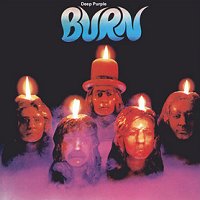 Ian Gillan and Roger Glover left Purple after "Who Do We Think We Are?" and the best line-up of the band was then history for 10 years. The replacements were David Coverdale and former Trapeze member Glenn Hughes. The vocals were shared between them, and they would soon bring major changes to the band's sound, unfortunately not for the better. But at first, the injection of new blood seemed to do the band good, as "Burned" turned out to be a surprisingly fine album. The title-track is an absolute killer that blows away everything on "Who Do We Think We Are?" and the new line-up couldn't have got a much better start. Other gems include "Sail Away", "Might Just Take Your Life" and the slow, emotional "Mistreated". The latter was obviously one of Blackmore's personal favourites, as it was included in the repertoire of his next band: Rainbow. The rhythms of "You Fool No One" was rather unusual for Purple, and Lord introduced synths for the first time in Purple's history on the instrumental ""A" 200". "What's Goin' On Here" is also a bit out of the usual as it's slightly more blues-influenced than average Purple. "Burn" is the only Purple album without Gillan and Glover that you'll need. Ian Gillan and Roger Glover left Purple after "Who Do We Think We Are?" and the best line-up of the band was then history for 10 years. The replacements were David Coverdale and former Trapeze member Glenn Hughes. The vocals were shared between them, and they would soon bring major changes to the band's sound, unfortunately not for the better. But at first, the injection of new blood seemed to do the band good, as "Burned" turned out to be a surprisingly fine album. The title-track is an absolute killer that blows away everything on "Who Do We Think We Are?" and the new line-up couldn't have got a much better start. Other gems include "Sail Away", "Might Just Take Your Life" and the slow, emotional "Mistreated". The latter was obviously one of Blackmore's personal favourites, as it was included in the repertoire of his next band: Rainbow. The rhythms of "You Fool No One" was rather unusual for Purple, and Lord introduced synths for the first time in Purple's history on the instrumental ""A" 200". "What's Goin' On Here" is also a bit out of the usual as it's slightly more blues-influenced than average Purple. "Burn" is the only Purple album without Gillan and Glover that you'll need.
Deep Purple - "Stormbringer" (Purple 1974)
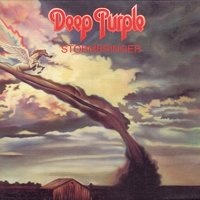 At first, everything looked very promising about the follow-up for "Burn". The cover was perhaps Purple's best ever, and the opening title-track was again a classic tune that even introduced fantasy-lyrics to the band. However, after that song it became very clear that Coverdale and Hughes had more or less taken over the whole band. And that means lots of bland blues, funk and soul on the expense of the classic hard rock that characterized Purple at their best. Lord had started to use clavinet and el-piano to keep pace with Coverdale and Hughes' vision to transform Purple into a funky band, but it doesn't do much else than further destroying Purple's personality and sound. The only other worthwhile track on the record is "Lady Double Dealer". This is a simple but fast and catchy rocker that feels like an oasis in between all the lifeless drivel. "Soldier of Fortune" is worth a note because of the inclusion of Mellotron (the only time on a Purple record I think) but the tune itself is a crappy ballad. I don't even care to say anything else about the other tracks. Borrow the album if you can, so you can tape the title-track. At first, everything looked very promising about the follow-up for "Burn". The cover was perhaps Purple's best ever, and the opening title-track was again a classic tune that even introduced fantasy-lyrics to the band. However, after that song it became very clear that Coverdale and Hughes had more or less taken over the whole band. And that means lots of bland blues, funk and soul on the expense of the classic hard rock that characterized Purple at their best. Lord had started to use clavinet and el-piano to keep pace with Coverdale and Hughes' vision to transform Purple into a funky band, but it doesn't do much else than further destroying Purple's personality and sound. The only other worthwhile track on the record is "Lady Double Dealer". This is a simple but fast and catchy rocker that feels like an oasis in between all the lifeless drivel. "Soldier of Fortune" is worth a note because of the inclusion of Mellotron (the only time on a Purple record I think) but the tune itself is a crappy ballad. I don't even care to say anything else about the other tracks. Borrow the album if you can, so you can tape the title-track.
Deep Purple - "Come Taste the Band" (Purple 1975)
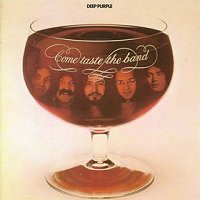 Ritchie Blackmore disliked the direction of "Stormbringer" so much that he left Purple, and formed his own band Rainbow instead. His replacement was Tommy Bolin, a promising and young guitarist who had a funky style of playing that fitted well with the direction Purple had moved into. Personally I think "Come Taste the Band" is a much better album than "Stormbringer". It's not a masterpiece or classic in any way, but it has its fair share of good riffs and melodies. Heavy tracks like "Drifter" and "Love Child" stands side by side with lighter and more melodic numbers like "I Need Love" and the single "You Keep On Moving". The ballad "This Time Around" and the instrumental "Owed to G" are connected to each other, and make a fine progressive piece. The funky tendencies are here still in "Gettin' Tighter" but in a much better and more fitting form than anything on "Stormbringer". And "Comin' Home" and "Lady Luck" are just straight forward rocking tracks of the enjoyable kind. Purple broke up after a disastrous tour for the album, and Bolin sadly died from a drug overdose shortly after. The classic MKII line-up reformed in 1984, but while the new albums and concerts may pleased the most fanatic fans, this period is absolutely uninteresting for casual listeners and they've now become little else than just another bunch of pathetic oldies who are cashing in on triumphs from a long gone past. Ritchie Blackmore disliked the direction of "Stormbringer" so much that he left Purple, and formed his own band Rainbow instead. His replacement was Tommy Bolin, a promising and young guitarist who had a funky style of playing that fitted well with the direction Purple had moved into. Personally I think "Come Taste the Band" is a much better album than "Stormbringer". It's not a masterpiece or classic in any way, but it has its fair share of good riffs and melodies. Heavy tracks like "Drifter" and "Love Child" stands side by side with lighter and more melodic numbers like "I Need Love" and the single "You Keep On Moving". The ballad "This Time Around" and the instrumental "Owed to G" are connected to each other, and make a fine progressive piece. The funky tendencies are here still in "Gettin' Tighter" but in a much better and more fitting form than anything on "Stormbringer". And "Comin' Home" and "Lady Luck" are just straight forward rocking tracks of the enjoyable kind. Purple broke up after a disastrous tour for the album, and Bolin sadly died from a drug overdose shortly after. The classic MKII line-up reformed in 1984, but while the new albums and concerts may pleased the most fanatic fans, this period is absolutely uninteresting for casual listeners and they've now become little else than just another bunch of pathetic oldies who are cashing in on triumphs from a long gone past.

|